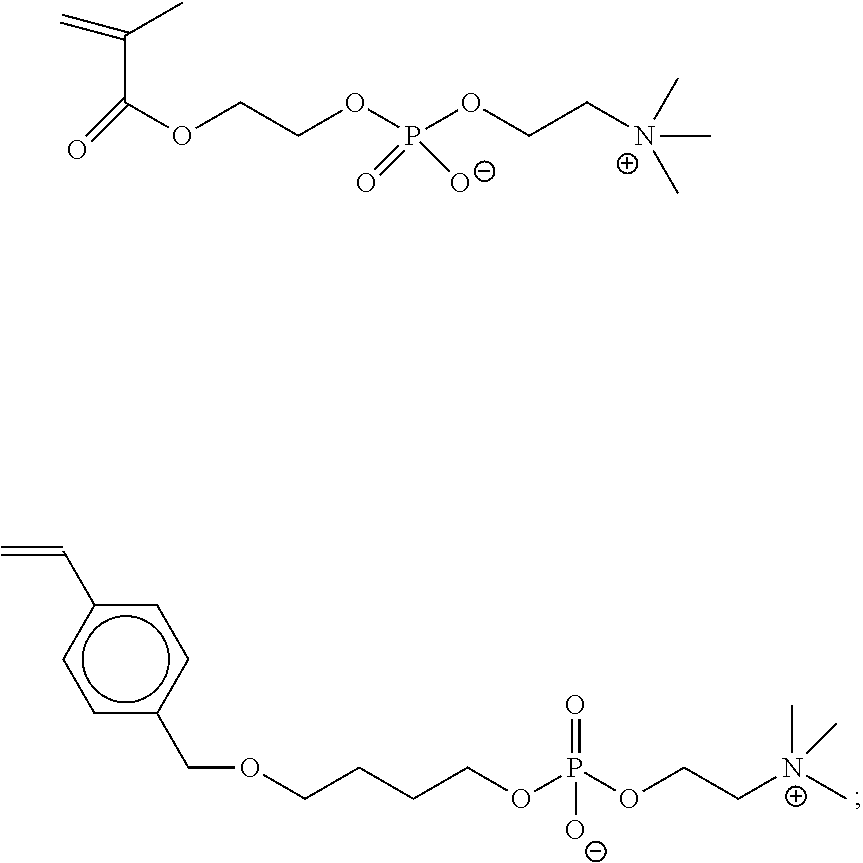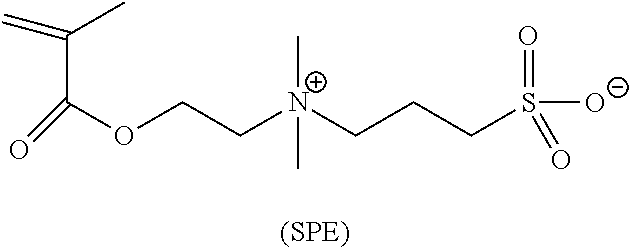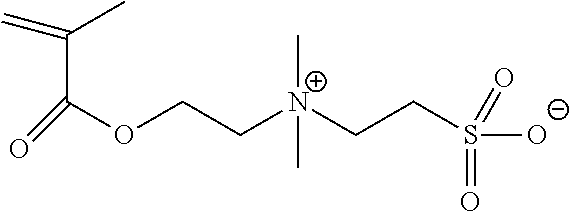Methods for reducing or preventing colloids adhesion and/or fouling on a substrate, compositions, and copolymers useful therefor
a technology of colloids and adhesion, applied in the direction of antifouling/underwater paints, biocides, coatings, etc., can solve the problems of unfavorable function and accumulation of unwanted materials on solid surfaces, and achieve the effect of reducing or preventing colloids adhesion and/or reducing or preventing colloids adhesion and/or fouling on the substra
- Summary
- Abstract
- Description
- Claims
- Application Information
AI Technical Summary
Benefits of technology
Problems solved by technology
Method used
Image
Examples
example 1
Synthesis of a Statistical Copolymer poly(vinyl phosphonic acid-stat-SPE) (poly(VPA-stat-SPE)) by Conventional Radical Polymerization (VPA=10 mol %:SPE=90 mol %)
[0184]In a 500 mL three-neck round-bottom flask equipped with a water condenser and a mechanical agitation, are introduced, 7 g of vinyl phosphonic acid (at 85.4% purity), 17.39 g of an aqueous solution of monomer SPE at 40 wt %, 24.01 g of an aqueous 2,2′-azobis(2-methylpropionamidine)dihydrochloride V50 solution at 5 wt % and 21.77 g of MilliQ water. The mixture was degassed and heated to 60° C., the temperature at which the remaining 330.42 g of the aqueous SPE solution was introduced by continuous feeding over 8 hours. At the end of the feeding, the reaction was held at temperature for two more hours. At the end of the polymerization, a sample was taken for 1H and 31P NMR analysis to determine the SPE and VPA monomer conversions. A sample was also taken for Size Exclusion Chromatography with Multi-Angle Light Scattering ...
example 2
Synthesis of a Statistical Copolymer poly(vinyl phosphonic acid-stat-(3-((3-acrylamidopropyl)dimethylammonio)-2-hydroxypropane-1-sulfonate) (poly(VPA-stat-AHPS)) by Conventional Radical Polymerization (Initiator: 2,2′-Azobis(2-methylpropionamidine) dihydrochloride) V50−VPA=10 mol %−AHPS=90 mol %)
[0190]In a 500 mL kettle reactor equipped with a water condenser and a mechanical agitation, were introduced, at room temperature (22° C.), 1 g (7.91 mmol) of a 85.4 wt % vinyl phosphonic acid aqueous solution, 41.89 g (71.15 mmol) of a 50 wt % AHPS aqueous solution and 175.09 g of distilled water. The mixture was degassed by bubbling nitrogen in the bulk for 50 minutes while the temperature in the solution was increased up to 60° C. After stabilization of the temperature at 60° C. in the kettle reactor, 21.44g (7.91 mmol) of a 10 wt % V50 aqueous solution was introduced under a nitrogen blanket. Then, simultaneously 376.98 g (640.31 mmol) of a 50 wt % AHPS aqueous solution was continuously ...
example 3
Synthesis of a Statistical Copolymer poly(vinyl phosphonic acid-stat-3-((3-acrylamidopropyl)dimethylammonio)-2-hydroxypropane-1-sulfonate)-stat-2-hydroxyethyl acrylate) (poly(VPA-stat-AHPS-stat-HEA)) by Conventional Radical Polymerization (Initiator: 2,2′-Azobis(2-methylpropionamidine) dihydrochloride) V50−VPA=10 mol %−AHPS=30 mol %−HEA=60 mol %)
[0206]In a 500 mL kettle reactor equipped with a water condenser and a mechanical agitation, were introduced, at room temperature (22° C.), 13 g (102.8 mmol) of a 85.4 wt % vinyl phosphonic acid aqueous solution, 9.08 g (15.4 mmol) of a 50 wt % AHPS aqueous solution, 4.59 g (30.8 mmol) of a 78 wt % HEA aqueous solution and 130.01 g of distilled water. The mixture was degassed by bubbling nitrogen in the bulk and the temperature in the solution was increased up to 60° C. over 50 minutes. Once the temperature in the kettle reactor was stabilized at 60° C., 27.9 g (10.3 mmol) of a 10 wt % V50 aqueous solution was introduced under a nitrogen bla...
PUM
| Property | Measurement | Unit |
|---|---|---|
| mol % | aaaaa | aaaaa |
| weight-average molar mass | aaaaa | aaaaa |
| weight-average molar mass | aaaaa | aaaaa |
Abstract
Description
Claims
Application Information
 Login to View More
Login to View More - R&D
- Intellectual Property
- Life Sciences
- Materials
- Tech Scout
- Unparalleled Data Quality
- Higher Quality Content
- 60% Fewer Hallucinations
Browse by: Latest US Patents, China's latest patents, Technical Efficacy Thesaurus, Application Domain, Technology Topic, Popular Technical Reports.
© 2025 PatSnap. All rights reserved.Legal|Privacy policy|Modern Slavery Act Transparency Statement|Sitemap|About US| Contact US: help@patsnap.com



